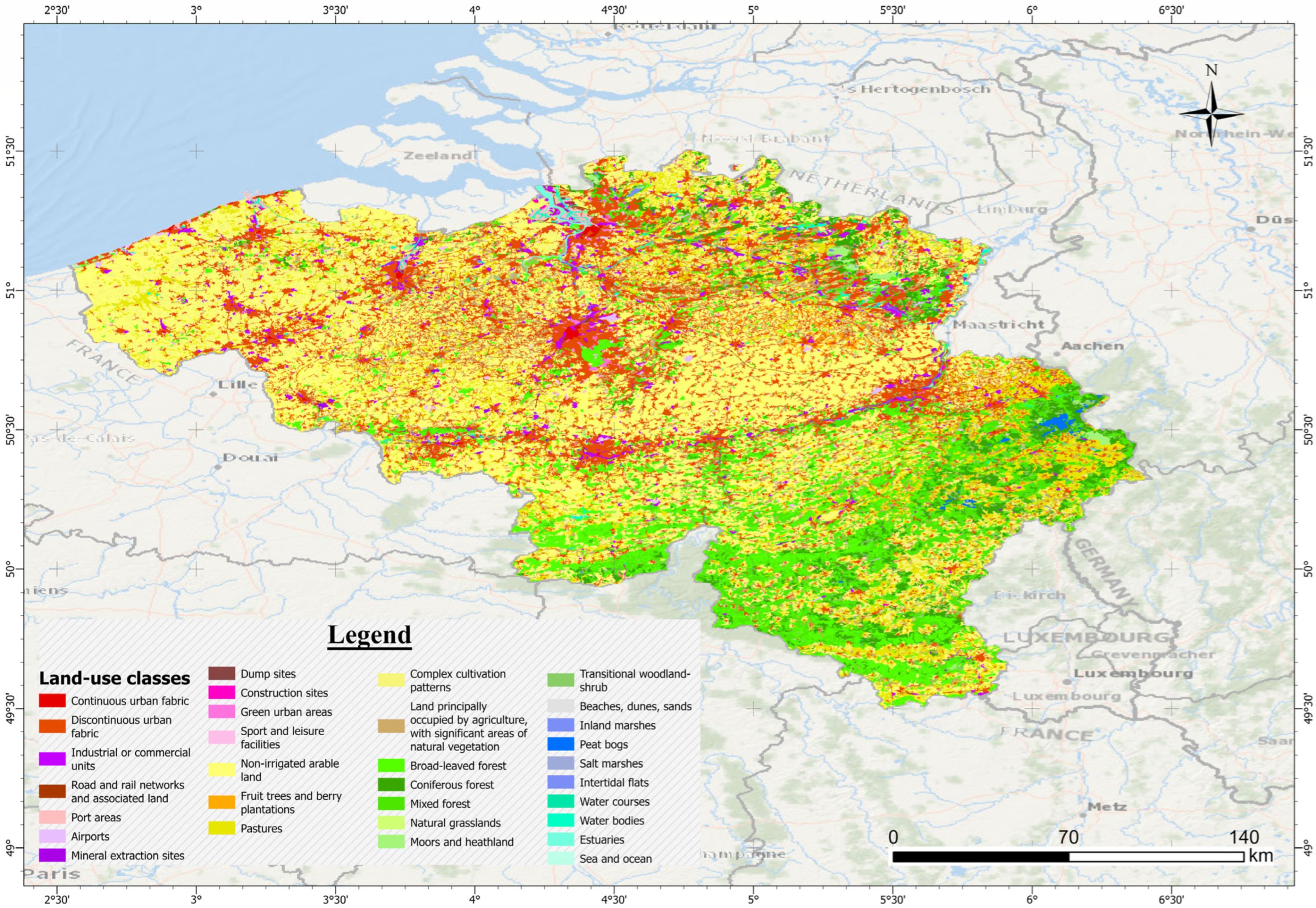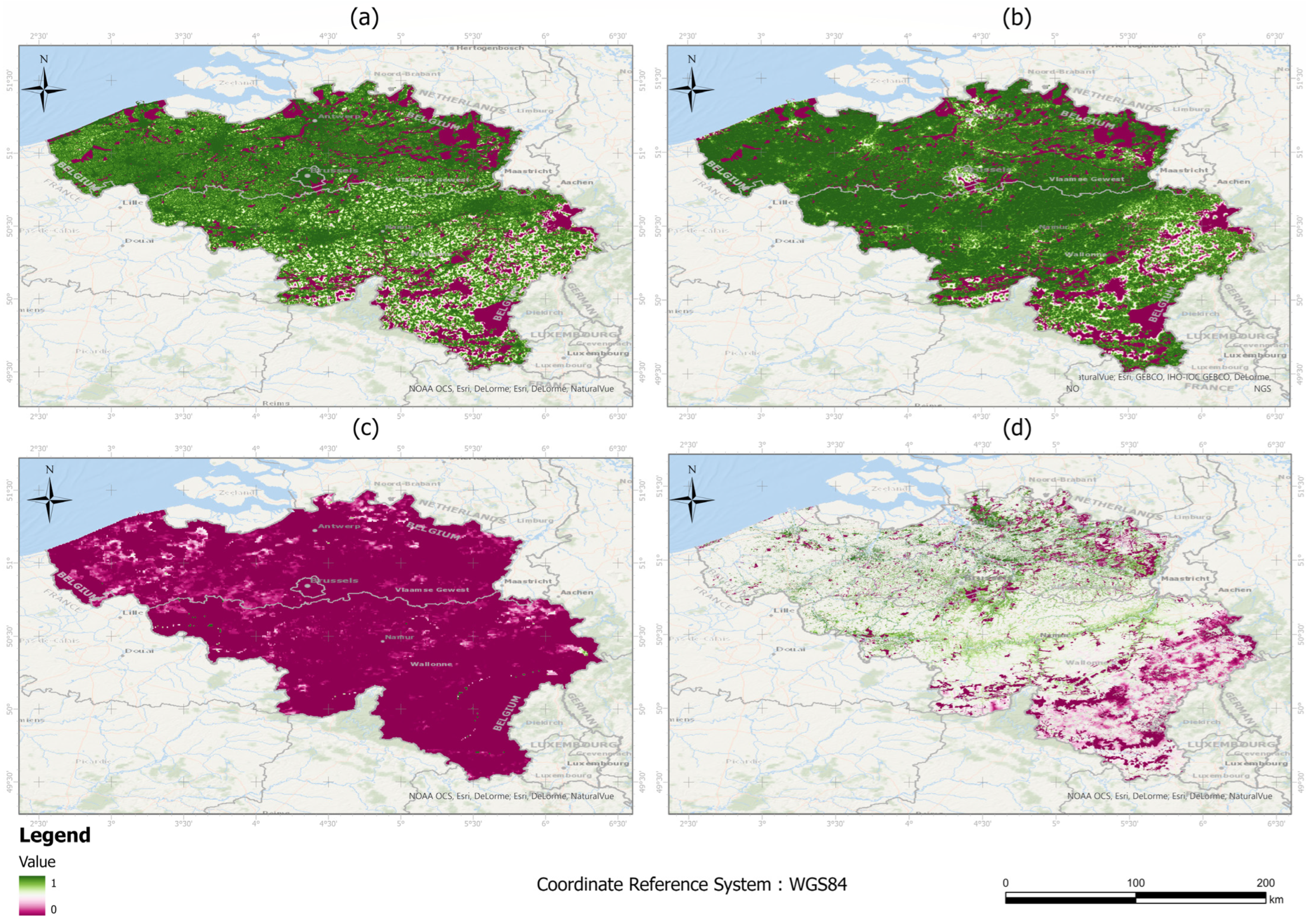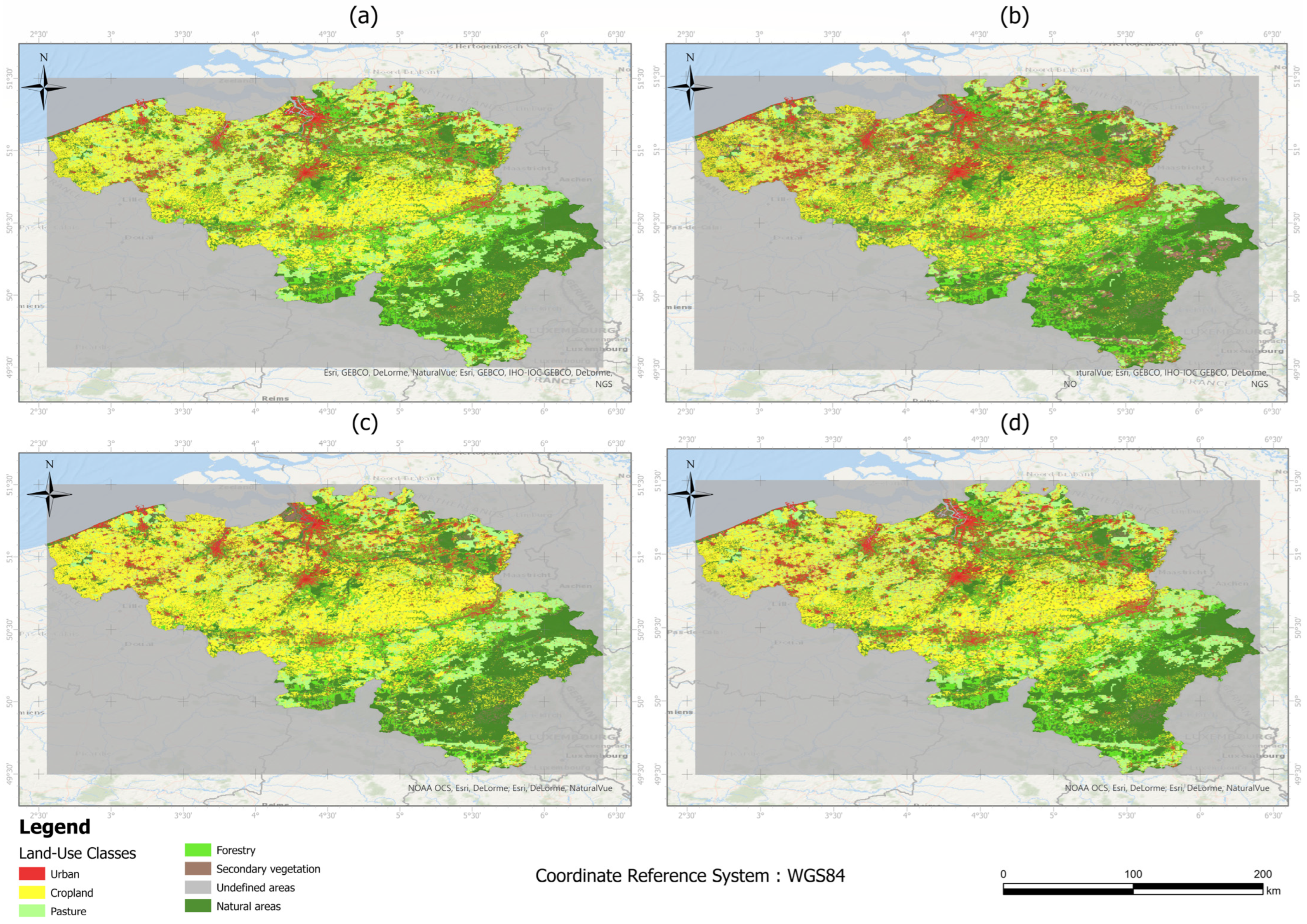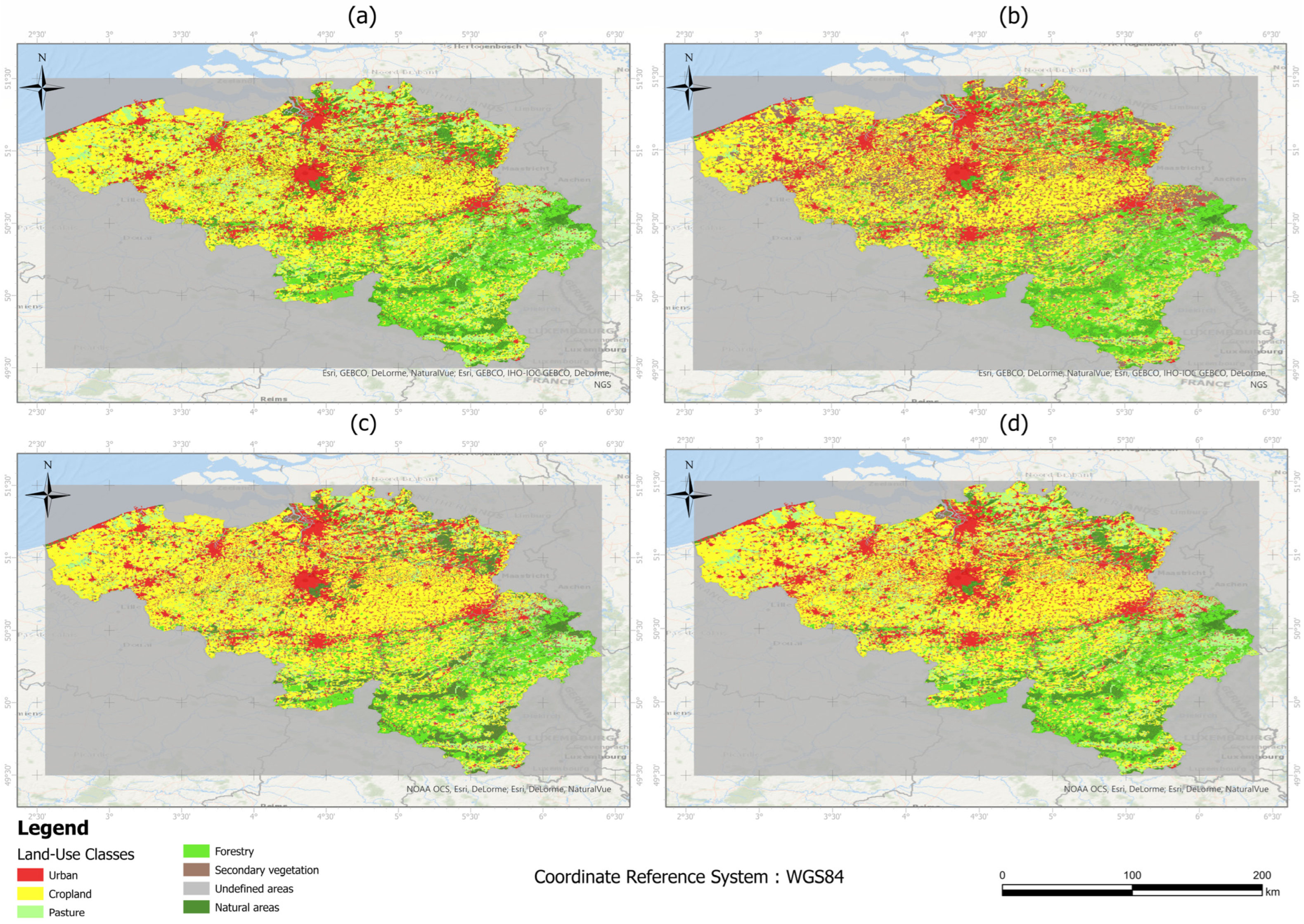Downscaling Global Land-Use Scenario Data to the National Level: A Case Study for Belgium
Abstract
:1. Introduction
2. Materials and Methods
2.1. Case Study Area
2.2. LUH2 Data
2.3. GLOBIO Land-Use Downscaling Tool
2.4. Input Data Preparation
2.4.1. Reference Land Cover Maps
2.4.2. Suitability Layers
2.4.3. Claims
2.4.4. Non-Allocatable Areas
2.5. Evaluation and Validation of the Downscaled Maps
- nij represents the number of correctly classified pixels for class i
- N is the total number of pixels
- r = the number of the classes
- is the number of pixels that are correctly classified
- represents the number of pixels in a downscaled map
- represents the number of pixels in a reference data
- N is the total number of pixels
- r = the number of classes
- i = the i th class
- r: Total number of observations
- : Actual observed value for the i-th observation
- : Value predicted by the model for the i-th observation
- : Calculated mean of the observed values
- : standard deviation of observed data
3. Results
3.1. Downscaled Land-Use Maps
3.2. Comparison of the Downscaled Maps and the Original LUH2 Data
3.3. Independent Validation of Present-Day Downscaled Maps
4. Discussion
4.1. Land Use Downscaling
4.2. Choice of Reference Land Cover Map
4.3. Scenario Projections
4.4. Implications and Outlook
5. Conclusions
Author Contributions
Funding
Data Availability Statement
Conflicts of Interest
References
- Albert, C.H.; Hervé, M.; Fader, M.; Bondeau, A.; Leriche, A.; Monnet, A.C.; Cramer, W. What Ecologists Should Know before Using Land Use/Cover Change Projections for Biodiversity and Ecosystem Service Assessments. Reg. Environ. Chang. 2020, 20, 106. [Google Scholar] [CrossRef]
- Di Marco, M.; Harwood, T.D.; Hoskins, A.J.; Ware, C.; Hill, S.L.L.; Ferrier, S. Projecting Impacts of Global Climate and Land-Use Scenarios on Plant Biodiversity Using Compositional-Turnover Modelling. Glob. Chang. Biol. 2019, 25, 2763–2778. [Google Scholar] [CrossRef] [PubMed]
- Schipper, A.M.; Hilbers, J.P.; Meijer, J.R.; Antão, L.H.; Benítez-López, A.; de Jonge, M.M.J.; Leemans, L.H.; Scheper, E.; Alkemade, R.; Doelman, J.C.; et al. Projecting Terrestrial Biodiversity Intactness with GLOBIO 4. Glob. Chang. Biol. 2020, 26, 760–771. [Google Scholar] [CrossRef] [PubMed]
- Radinger, J.; Hölker, F.; Horký, P.; Slavík, O.; Dendoncker, N.; Wolter, C. Synergistic and Antagonistic Interactions of Future Land Use and Climate Change on River Fish Assemblages. Glob. Chang. Biol. 2016, 22, 1505–1522. [Google Scholar] [CrossRef] [PubMed]
- Oliver, T.H.; Morecroft, M.D. Interactions between Climate Change and Land Use Change on Biodiversity: Attribution Problems, Risks, and Opportunities. Wiley Interdiscip. Rev. Clim. Chang. 2014, 5, 317–335. [Google Scholar] [CrossRef]
- Hürlimann, M.; Guo, Z.; Puig-Polo, C.; Medina, V. Impacts of Future Climate and Land Cover Changes on Landslide Susceptibility: Regional Scale Modelling in the Val d’Aran Region (Pyrenees, Spain). Landslides 2022, 19, 99–118. [Google Scholar] [CrossRef]
- Liu, J.; Wu, Z.; Zhang, H. Analysis of Changes in Landslide Susceptibility According to Land Use over 38 Years in Lixian County, China. Sustainability 2021, 13, 858. [Google Scholar] [CrossRef]
- Guo, Z.; Ferrer, J.V.; Hürlimann, M.; Medina, V.; Puig-Polo, C.; Yin, K.; Huang, D. Shallow Landslide Susceptibility Assessment under Future Climate and Land Cover Changes: A Case Study from Southwest China. Geosci. Front. 2023, 14, 101542. [Google Scholar] [CrossRef]
- Sadhwani, K.; Eldho, T.I.; Karmakar, S. Investigating the Influence of Future Landuse and Climate Change on Hydrological Regime of a Humid Tropical River Basin. Environ. Earth Sci. 2023, 82, 210. [Google Scholar] [CrossRef]
- Kim, H.; Rosa, I.M.D.; Alkemade, R.; Leadley, P.; Hurtt, G.; Popp, A.; Van Vuuren, D.P.; Anthoni, P.; Arneth, A.; Baisero, D.; et al. A Protocol for an Intercomparison of Biodiversity and Ecosystem Services Models Using Harmonized Land-Use and Climate Scenarios. Geosci. Model Dev. 2018, 11, 4537–4562. [Google Scholar] [CrossRef]
- van Vuuren, D.P.; Edmonds, J.; Kainuma, M.; Riahi, K.; Thomson, A.; Hibbard, K.; Hurtt, G.C.; Kram, T.; Krey, V.; Lamarque, J.F.; et al. The Representative Concentration Pathways: An Overview. Clim. Chang. 2011, 109, 5–31. [Google Scholar] [CrossRef]
- Popp, A.; Calvin, K.; Fujimori, S.; Havlik, P.; Humpenöder, F.; Stehfest, E.; Bodirsky, B.L.; Dietrich, J.P.; Doelmann, J.C.; Gusti, M.; et al. Land-Use Futures in the Shared Socio-Economic Pathways. Glob. Environ. Chang. 2017, 42, 331–345. [Google Scholar] [CrossRef]
- Riahi, K.; van Vuuren, D.P.; Kriegler, E.; Edmonds, J.; O’Neill, B.C.; Fujimori, S.; Bauer, N.; Calvin, K.; Dellink, R.; Fricko, O.; et al. The Shared Socioeconomic Pathways and Their Energy, Land Use, and Greenhouse Gas Emissions Implications: An Overview. Glob. Environ. Chang. 2017, 42, 153–168. [Google Scholar] [CrossRef]
- van Vuuren, D.P.; Kriegler, E.; O’Neill, B.C.; Ebi, K.L.; Riahi, K.; Carter, T.R.; Edmonds, J.; Hallegatte, S.; Kram, T.; Mathur, R.; et al. A New Scenario Framework for Climate Change Research: Scenario Matrix Architecture. Clim. Chang. 2014, 122, 373–386. [Google Scholar] [CrossRef]
- Rosenzweig, C.; Arnell, N.W.; Ebi, K.L.; Lotze-Campen, H.; Raes, F.; Rapley, C.; Smith, M.S.; Cramer, W.; Frieler, K.; Reyer, C.P.O.; et al. Assessing Inter-Sectoral Climate Change Risks: The Role of ISIMIP. Environ. Res. Lett. 2017, 12, 010301. [Google Scholar] [CrossRef]
- Frame, B.; Lawrence, J.; Ausseil, A.G.; Reisinger, A.; Daigneault, A. Adapting Global Shared Socio-Economic Pathways for National and Local Scenarios. Clim. Risk Manag. 2018, 21, 39–51. [Google Scholar] [CrossRef]
- Hurtt, G.C.; Chini, L.; Sahajpal, R.; Frolking, S.; Bodirsky, B.L.; Calvin, K.; Doelman, J.C.; Fisk, J.; Fujimori, S.; Klein Goldewijk, K.; et al. Harmonization of Global Land Use Change and Management for the Period 850-2100 (LUH2) for CMIP6. Geosci. Model Dev. 2020, 13, 5425–5464. [Google Scholar] [CrossRef]
- Liao, W.; Liu, X.; Xu, X.; Chen, G.; Liang, X.; Zhang, H.; Li, X. Projections of Land Use Changes under the Plant Functional Type Classification in Different SSP-RCP Scenarios in China. Sci. Bull. 2020, 65, 1935–1947. [Google Scholar] [CrossRef]
- Hoskins, A.J.; Bush, A.; Gilmore, J.; Harwood, T.; Hudson, L.N.; Ware, C.; Williams, K.J.; Ferrier, S. Downscaling Land-Use Data to Provide Global 30” Estimates of Five Land-Use Classes. Ecol. Evol. 2016, 6, 3040–3055. [Google Scholar] [CrossRef]
- Li, X.; Chen, G.; Liu, X.; Liang, X.; Wang, S.; Chen, Y.; Pei, F.; Xu, X. A New Global Land-Use and Land-Cover Change Product at a 1-Km Resolution for 2010 to 2100 Based on Human–Environment Interactions. Ann. Am. Assoc. Geogr. 2017, 107, 1040–1059. [Google Scholar] [CrossRef]
- Schaldach, R.; Alcamo, J.; Koch, J.; Kölking, C.; Lapola, D.M.; Schüngel, J.; Priess, J.A. An Integrated Approach to Modelling Land-Use Change on Continental and Global Scales. Environ. Model. Softw. 2011, 26, 1041–1051. [Google Scholar] [CrossRef]
- Kuipers, K.J.J.; Hilbers, J.P.; Garcia-Ulloa, J.; Graae, B.J.; May, R.; Verones, F.; Huijbregts, M.A.J.; Schipper, A.M. Habitat Fragmentation Amplifies Threats from Habitat Loss to Mammal Diversity across the World’s Terrestrial Ecoregions. One Earth 2021, 4, 1505–1513. [Google Scholar] [CrossRef]
- Schulp, C.J.E.; Alkemade, R. Consequences of Uncertainty in Global-Scale Land Cover Maps for Mapping Ecosystem Functions: An Analysis of Pollination Efficiency. Remote Sens. 2011, 3, 2057–2075. [Google Scholar] [CrossRef]
- Giuliani, G.; Rodila, D.; Külling, N.; Maggini, R.; Lehmann, A. Downscaling Switzerland Land Use/Land Cover Data Using Nearest Neighbors and an Expert System. Land 2022, 11, 615. [Google Scholar] [CrossRef]
- Vandenbulcke, G.; Steenberghen, T.; Thomas, I. Mapping Accessibility in Belgium: A Tool for Land-Use and Transport Planning? J. Transp. Geogr. 2009, 17, 39–53. [Google Scholar] [CrossRef]
- Beckers, V.; Poelmans, L.; Van Rompaey, A.; Dendoncker, N. The Impact of Urbanization on Agricultural Dynamics: A Case Study in Belgium. J. Land Use Sci. 2020, 15, 626–643. [Google Scholar] [CrossRef]
- Dendoncker, N.; Bogaert, P.; Rounsevell, M. A Statistical Method to Downscale Aggregated Land Use Data and Scenarios. J. Land Use Sci. 2006, 1, 63–82. [Google Scholar] [CrossRef]
- O’Neill, B.C.; Tebaldi, C.; Van Vuuren, D.P.; Eyring, V.; Friedlingstein, P.; Hurtt, G.; Knutti, R.; Kriegler, E.; Lamarque, J.F.; Lowe, J.; et al. The Scenario Model Intercomparison Project (ScenarioMIP) for CMIP6. Geosci. Model Dev. 2016, 9, 3461–3482. [Google Scholar] [CrossRef]
- Jungclaus, J.H.; Bard, E.; Baroni, M.; Braconnot, P.; Cao, J.; Chini, L.P.; Egorova, T.; Evans, M.; Fidel González-Rouco, J.; Goosse, H.; et al. The PMIP4 Contribution to CMIP6-Part 3: The Last Millennium, Scientific Objective, and Experimental Design for the PMIP4 Past1000 Simulations. Geosci. Model Dev. 2017, 10, 4005–4033. [Google Scholar] [CrossRef]
- Lawrence, P.J.; Feddema, J.J.; Bonan, G.B.; Meehl, G.A.; O’Neill, B.C.; Oleson, K.W.; Levis, S.; Lawrence, D.M.; Kluzek, E.; Lindsay, K.; et al. Simulating the Biogeochemical and Biogeophysical Impacts of Transient Land Cover Change and Wood Harvest in the Community Climate System Model (CCSM4) from 1850 to 2100. J. Clim. 2012, 25, 3071–3095. [Google Scholar] [CrossRef]
- Pereira, H.M.; Rosa, I.M.D.; Martins, I.S.; Kim, H.; Leadley, P.; Popp, A.; Van Vuuren, D.P.; Hurtt, G.; Anthoni, P.; Arneth, A.; et al. Global Trends in Biodiversity and Ecosystem Services from 1900 to 2050. BioRxiv 2020. [Google Scholar] [CrossRef]
- Alkemade, R.; Van Oorschot, M.; Miles, L.; Nellemann, C.; Bakkenes, M.; Ten Brink, B. GLOBIO3: A Framework to Investigate Options for Reducing Global Terrestrial Biodiversity Loss. Ecosystems 2009, 12, 374–390. [Google Scholar] [CrossRef]
- D’Amour, C.B.; Reitsma, F.; Baiocchi, G.; Barthel, S.; Güneralp, B.; Erb, K.H.; Haberl, H.; Creutzig, F.; Seto, K.C. Future Urban Land Expansion and Implications for Global Croplands. Proc. Natl. Acad. Sci. USA 2017, 114, 8939–8944. [Google Scholar] [CrossRef]
- Hasegawa, T.; Fujimori, S.; Ito, A.; Takahashi, K.; Masui, T. Global Land-Use Allocation Model Linked to an Integrated Assessment Model. Sci. Total Environ. 2017, 580, 787–796. [Google Scholar] [CrossRef] [PubMed]
- Zanaga, D.; Van De Kerchove, R.; Daems, D.; De Keersmaecker, W.; Brockmann, C.; Kirches, G.; Wevers, J.; Cartus, O.; Santoro, M.; Fritz, S.; et al. ESA WorldCover 10 m 2021 V200. 2022. Available online: https://zenodo.org/record/7254221 (accessed on 2 September 2023).
- Huang, X.; Xia, J.; Xiao, R.; He, T. Urban Expansion Patterns of 291 Chinese Cities, 1990–2015. Int. J. Digit. Earth 2019, 12, 62–77. [Google Scholar] [CrossRef]
- Lo, A.Y.; Byrne, J.A.; Jim, C.Y. How Climate Change Perception Is Reshaping Attitudes towards the Functional Benefits of Urban Trees and Green Space: Lessons from Hong Kong. Urban For. Urban Green. 2017, 23, 74–83. [Google Scholar] [CrossRef]
- Richards, P. It’s Not Just Where You Farm; It’s Whether Your Neighbor Does Too. How Agglomeration Economies Are Shaping New Agricultural Landscapes. J. Econ. Geogr. 2018, 18, 87–110. [Google Scholar] [CrossRef]
- Robinson, T.P.; William Wint, G.R.; Conchedda, G.; Van Boeckel, T.P.; Ercoli, V.; Palamara, E.; Cinardi, G.; D’Aietti, L.; Hay, S.I.; Gilbert, M. Mapping the Global Distribution of Livestock. PLoS ONE 2014, 9, e96084. [Google Scholar] [CrossRef]
- Petz, K.; Alkemade, R.; Bakkenes, M.; Schulp, C.J.E.; van der Velde, M.; Leemans, R. Mapping and Modelling Trade-Offs and Synergies between Grazing Intensity and Ecosystem Services in Rangelands Using Global-Scale Datasets and Models. Glob. Environ. Chang. 2014, 29, 223–234. [Google Scholar] [CrossRef]
- Meijer, J.R.; Huijbregts, M.A.J.; Schotten, K.C.G.J.; Schipper, A.M. Global Patterns of Current and Future Road Infrastructure. Environ. Res. Lett. 2018, 13, 064006. [Google Scholar] [CrossRef]
- Buchhorn, M.; Smets, B.; Bertels, L.; De Roo, B.; Lesiv, M.; Tsendbazar, N.-E.; Herold, M.; Fritz, S. Copernicus Global Land Service: Land Cover 100m: Collection 3: Epoch 2015: Globe. 2020. Available online: https://zenodo.org/record/3939038 (accessed on 2 September 2023).
- Chen, D.; Stow, D.A.; Gong, P. Examining the Effect of Spatial Resolution and Texture Window Size on Classification Accuracy: An Urban Environment Case. Int. J. Remote Sens. 2004, 25, 2177–2192. [Google Scholar] [CrossRef]
- Franklin, S.E.; Wulder, M.A. Remote Sensing Methods in Medium Spatial Resolution Satellite Data Land Cover Classification of Large Areas. Prog. Phys. Geogr. 2002, 26, 173–205. [Google Scholar] [CrossRef]
- Lunetta, R.S.; Knight, J.F.; Ediriwickrema, J.; Lyon, J.G.; Worthy, L.D. Land-Cover Change Detection Using Multi-Temporal MODIS NDVI Data. Remote Sens. Environ. 2006, 105, 142–154. [Google Scholar] [CrossRef]
- Ren, H.; Cai, G.; Zhao, G.; Li, Z. Accuracy Assessment of the GlobeLand30 Dataset in Jiangxi Province. Int. Arch. Photogramm. Remote Sens. Spatial Inf. Sci. 2018, 42, 1481–1487. [Google Scholar] [CrossRef]
- Koubodana, D.H.; Diekkrüger, B.; Näschen, K.; Adounkpe, J.; Atchonouglo, K. Impact of the Accuracy of Land Cover Data Sets on the Accuracy of Land Cover Change Scenarios in the Mono River Basin, Togo, West Africa. Int. J. Adv. Remote Sens. GIS 2019, 8, 3073–3095. [Google Scholar] [CrossRef]
- Landis, J.R.; Koch, G.G. The Measurement of Observer Agreement for Categorical Data. Biometrics 1977, 33, 159–174. [Google Scholar] [CrossRef]
- Moriasi, D.N.; Arnold, J.G.; Van Liew, M.W.; Bingner, R.L.; Harmel, R.D.; Veith, T.L. Model Evaluation Guidelines for Systematic Quantification of Accuracy in Watershed Simulations. Trans. ASABE 2007, 50, 885–900. [Google Scholar] [CrossRef]
- Zeng, L.; Liu, X.; Li, W.; Ou, J.; Cai, Y.; Chen, G.; Li, M.; Li, G.; Zhang, H.; Xu, X. Global Simulation of Fine Resolution Land Use/Cover Change and Estimation of Aboveground Biomass Carbon under the Shared Socioeconomic Pathways. J. Environ. Manag. 2022, 312, 114943. [Google Scholar] [CrossRef] [PubMed]
- Mekonnen, Y.; Ghosh, S.K. Urban Growth and Land Use Simulation Using SLEUTH Model for Adama City, Ethiopia. In Proceedings of the ICAST 2019: Advances of Science and Technology, Bahir Dar, Ethiopia, 2–4 August 2019; Volume 308, pp. 279–293. [Google Scholar]
- Seto, K.C.; Güneralp, B.; Hutyra, L.R. Global Forecasts of Urban Expansion to 2030 and Direct Impacts on Biodiversity and Carbon Pools. Proc. Natl. Acad. Sci. USA 2012, 109, 16083–16088. [Google Scholar] [CrossRef]
- KC, S.; Lutz, W. The Human Core of the Shared Socioeconomic Pathways: Population Scenarios by Age, Sex and Level of Education for All Countries to 2100. Glob. Environ. Chang. 2017, 42, 181–192. [Google Scholar] [CrossRef]
- Dong, K.; Sun, R.; Dong, X. CO2 Emissions, Natural Gas and Renewables, Economic Growth: Assessing the Evidence from China. Sci. Total Environ. 2018, 640–641, 293–302. [Google Scholar] [CrossRef] [PubMed]
- Zhang, S.; Yang, P.; Xia, J.; Wang, W.; Cai, W.; Chen, N.; Hu, S.; Luo, X.; Li, J.; Zhan, C. Land Use/Land Cover Prediction and Analysis of the Middle Reaches of the Yangtze River under Different Scenarios. Sci. Total Environ. 2022, 833, 155238. [Google Scholar] [CrossRef]
- Martinuzzi, S.; Radeloff, V.C.; Joppa, L.N.; Hamilton, C.M.; Helmers, D.P.; Plantinga, A.J.; Lewis, D.J. Scenarios of Future Land Use Change around United States’ Protected Areas. Biol. Conserv. 2015, 184, 446–455. [Google Scholar] [CrossRef]
- Čengić, M.; Steinmann, Z.J.N.; Defourny, P.; Doelman, J.C.; Lamarche, C.; Stehfest, E.; Schipper, A.M.; Huijbregts, M.A.J. Global Maps of Agricultural Expansion Potential at a 300 m Resolution. Land 2023, 12, 579. [Google Scholar] [CrossRef]







| LUH2 | CORINE | ESA WorldCover | Downscaled Map |
|---|---|---|---|
| Urban land | Continuous urban fabric Discontinuous urban fabric Industrial or commercial units Road and rail networks and associated land Port areas Airports Mineral extraction sites Dump site Construction sites Green urban areas Sport and leisure facilities | Built-up | Urban |
| C3 annual crop C3 perennial crop C4 annual crop C4 perennial crop C3 nitrogen-fixing crop Non-irrigated arable land Fruit trees and berry plantations Complex cultivation patterns Land principally occupied by agriculture, with significant areas of natural vegetation | Non-irrigated arable land Fruit trees and berry plantations Complex cultivation patterns Land principally occupied by agriculture, with significant areas of natural vegetation | Cropland | Cropland |
| Managed pasture Rangeland | Pasture | NA | Pasture |
| Forested primary land Potentially forested secondary land Non-forested primary land Potentially non-forested secondary land | Broad-leaved forest Coniferous forest Mixed forest Moors and heathland Transitional woodland-shrub Natural grasslands Beaches, dunes, sands | Tree cover Shrubland Grassland Bare/sparse vegetation | Natural |
| NA | Glaciers and perpetual snow Inland marshes Peat bogs Salt marshes Intertidal flats Water courses Water bodies Estuaries Sea and ocean | Open water Herbaceous wetland | Not allocatable |
| Land Use Type | 2015 | Sustainability Scenario | Regional Rivalry Scenario | Fossil-Fuelled Development Scenario | |||
|---|---|---|---|---|---|---|---|
| Area (km2) | Area (km2) | Change (%) | Area (km2) | Change (%) | Area (km2) | Change (%) | |
| Urban | 3134 | 3635 | 16 | 3346 | 6 | 4011 | 28 |
| Cropland | 8601 | 7227 | −16 | 10,866 | 26 | 8813 | 2 |
| Pasture | 5886 | 3137 | −47 | 4781 | −18 | 5886 | 0 |
| Forestry | 4609 | 5431 | 18 | 3980 | −6 | 4375 | −5 |
| Scenarios | RSR (RMSE-Observations Standard Deviation Ratio) | Overall Accuracy (Ô) | Kappa Coefficient (K) | ||||||
|---|---|---|---|---|---|---|---|---|---|
| CORINE Land Cover (100 m) | ESA World Cover (100 m) | ESA World Cover (10 m) | CORINE Land Cover (100 m) | ESA World Cover (100 m) | ESA World Cover (10 m) | CORINE Land Cover (100 m) | ESA World Cover (100 m) | ESA World Cover (10 m) | |
| Present day | 0.31 | 0.20 | 0.14 | 0.93 | 0.95 | 0.98 | 0. 91 | 0.93 | 0.97 |
| Sustainability scenario | 0.33 | 0.24 | 0.17 | 0.92 | 0.94 | 0.97 | 0.90 | 0.91 | 0.96 |
| Regional rivalry scenario | 0.28 | 0.17 | 0.11 | 0.92 | 0.94 | 0.97 | 0.90 | 0.92 | 0.96 |
| Fossil-fuelled development scenario | 0.33 | 0.21 | 0.15 | 0.93 | 0.96 | 0.98 | 0.91 | 0.93 | 0.97 |
| Land Use Type | Present Day | Sustainability Scenario (2050) | Regional Rivalry Scenario (2050) | Fossil-Fuelled Development Scenario (2050) | |||
|---|---|---|---|---|---|---|---|
| Area (km2) | Area (km2) | Change (%) | Area (km2) | Change (%) | Area (km2) | Change (%) | |
| Urban | 2722 | 3223 | 18 | 2934 | 8 | 3599 | 32 |
| Cropland | 8843 | 7469 | −15 | 11,108 | 25 | 9055 | 2 |
| Pasture | 6203 | 3454 | −44 | 5098 | −18 | 6203 | 0 |
| Forestry | 4560 | 5382 | 18 | 3931 | −14 | 4326 | −5 |
| Land Use Type | Present Day | Sustainability Scenario (2050) | Regional Rivalry Scenario (2050) | Fossil-Fuelled Development Scenario (2050) | |||
|---|---|---|---|---|---|---|---|
| Area (km2) | Area (km2) | Change (%) | Area (km2) | Change (%) | Area (km2) | Change (%) | |
| Urban | 1966 | 2467 | 25 | 2178 | 11 | 2843 | 44 |
| Cropland | 5781 | 4407 | −23 | 8046 | 39 | 5993 | 4 |
| Pasture | 5602 | 2853 | −49 | 4497 | −20 | 5602 | 0 |
| Forestry | 4601 | 5423 | 19 | 3972 | −13 | 4216 | −7 |
| Land Use Type | Present Day | Sustainability Scenario | Regional Rivalry Scenario | Fossil-Fuelled Development Scenario | |||
|---|---|---|---|---|---|---|---|
| Area (km2) | Area (km2) | Change (%) | Area (km2) | Change (%) | Area (km2) | Change (%) | |
| Urban | 4355 | 4856 | 11 | 4567 | 5 | 5232 | 20 |
| Cropland | 13,397 | 12,023 | −10 | 15,662 | 17 | 13,609 | 2 |
| Pasture | 4873 | 2124 | −56 | 3768 | −23 | 4873 | 0 |
| Forestry | 4549 | 5371 | 18 | 3929 | −13 | 4315 | −5 |
| Evaluation Measure | Downscaled Product Based on | ||
|---|---|---|---|
| ESA WorldCover (10 m) | Upscaled ESA WorldCover (100 m) | CORINE Land Cover (100 m) | |
| Overall accuracy | 0.95 | 0.92 | 0.90 |
| Kappa statistic | 0.87 | 0.81 | 0.74 |
| RSR | 0.34 | 0.46 | 0.60 |
Disclaimer/Publisher’s Note: The statements, opinions and data contained in all publications are solely those of the individual author(s) and contributor(s) and not of MDPI and/or the editor(s). MDPI and/or the editor(s) disclaim responsibility for any injury to people or property resulting from any ideas, methods, instructions or products referred to in the content. |
© 2023 by the authors. Licensee MDPI, Basel, Switzerland. This article is an open access article distributed under the terms and conditions of the Creative Commons Attribution (CC BY) license (https://creativecommons.org/licenses/by/4.0/).
Share and Cite
Rashidi, P.; Patil, S.D.; Schipper, A.M.; Alkemade, R.; Rosa, I. Downscaling Global Land-Use Scenario Data to the National Level: A Case Study for Belgium. Land 2023, 12, 1740. https://doi.org/10.3390/land12091740
Rashidi P, Patil SD, Schipper AM, Alkemade R, Rosa I. Downscaling Global Land-Use Scenario Data to the National Level: A Case Study for Belgium. Land. 2023; 12(9):1740. https://doi.org/10.3390/land12091740
Chicago/Turabian StyleRashidi, Parinaz, Sopan D. Patil, Aafke M. Schipper, Rob Alkemade, and Isabel Rosa. 2023. "Downscaling Global Land-Use Scenario Data to the National Level: A Case Study for Belgium" Land 12, no. 9: 1740. https://doi.org/10.3390/land12091740
APA StyleRashidi, P., Patil, S. D., Schipper, A. M., Alkemade, R., & Rosa, I. (2023). Downscaling Global Land-Use Scenario Data to the National Level: A Case Study for Belgium. Land, 12(9), 1740. https://doi.org/10.3390/land12091740







